MITSUBISHI SHOGUN 2017 Owner's Manual (in English)
Manufacturer: MITSUBISHI, Model Year: 2017, Model line: SHOGUN, Model: MITSUBISHI SHOGUN 2017Pages: 394, PDF Size: 19 MB
Page 141 of 394
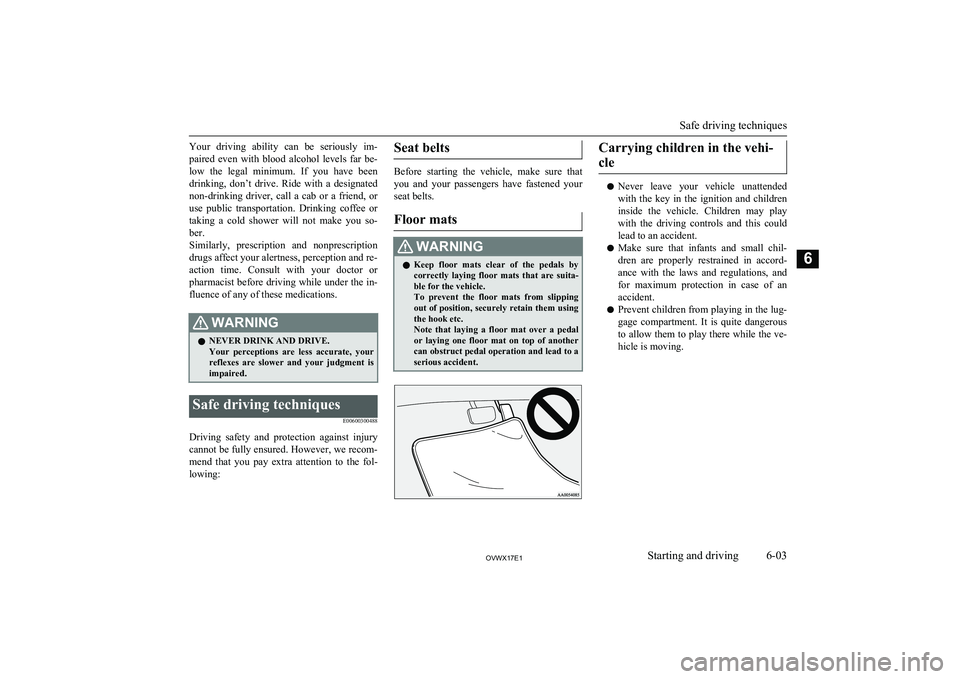
Your driving ability can be seriously im-
paired even with blood alcohol levels far be- low the legal minimum. If you have beendrinking, don’t drive. Ride with a designated
non-drinking driver, call a cab or a friend, or
use public transportation. Drinking coffee or taking a cold shower will not make you so-ber.
Similarly, prescription and nonprescription
drugs affect your alertness, perception and re- action time. Consult with your doctor or
pharmacist before driving while under the in- fluence of any of these medications.WARNINGl NEVER DRINK AND DRIVE.
Your perceptions are less accurate, your reflexes are slower and your judgment is
impaired.Safe driving techniques
E00600300488
Driving safety and protection against injury
cannot be fully ensured. However, we recom- mend that you pay extra attention to the fol-
lowing:
Seat belts
Before starting the vehicle, make sure that
you and your passengers have fastened your seat belts.
Floor mats
WARNINGl Keep floor mats clear of the pedals by
correctly laying floor mats that are suita-
ble for the vehicle.
To prevent the floor mats from slipping out of position, securely retain them usingthe hook etc.
Note that laying a floor mat over a pedal
or laying one floor mat on top of another can obstruct pedal operation and lead to a
serious accident.Carrying children in the vehi-
cle
l Never leave your vehicle unattended
with the key in the ignition and children
inside the vehicle. Children may play with the driving controls and this could
lead to an accident.
l Make sure that infants and small chil-
dren are properly restrained in accord-
ance with the laws and regulations, and for maximum protection in case of an
accident.
l Prevent children from playing in the lug-
gage compartment. It is quite dangerousto allow them to play there while the ve-
hicle is moving.
Safe driving techniques
6-03OVWX17E1Starting and driving6
Page 142 of 394
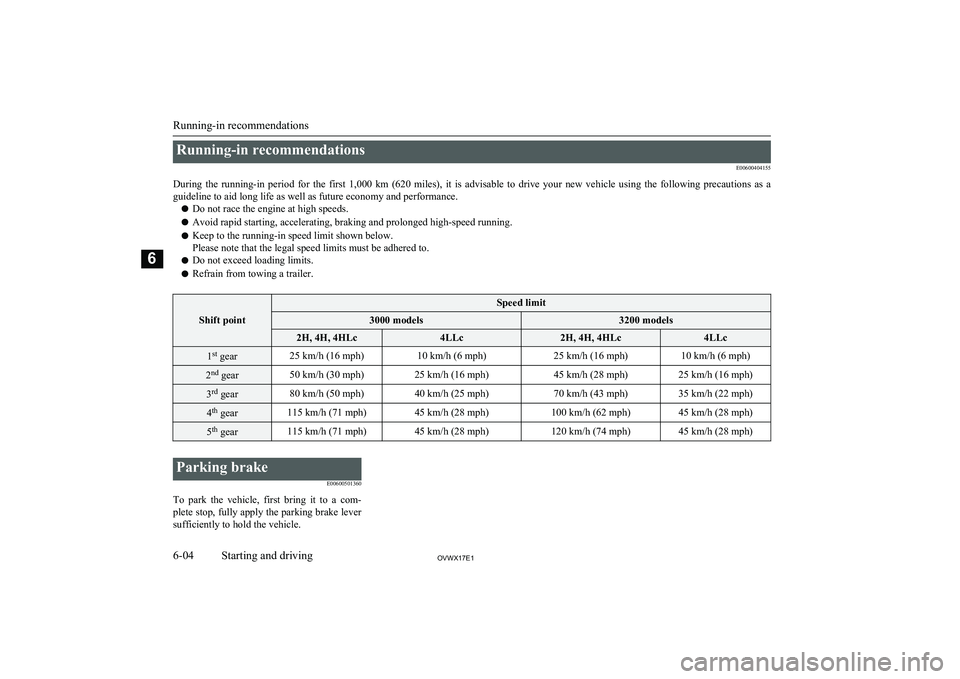
Running-in recommendationsE00600404155
During the running-in period for the first 1,000 km (620 miles), it is advisable to drive your new vehicle using the following precautions as a guideline to aid long life as well as future economy and performance.
l Do not race the engine at high speeds.
l Avoid rapid starting, accelerating, braking and prolonged high-speed running.
l Keep to the running-in speed limit shown below.
Please note that the legal speed limits must be adhered to.
l Do not exceed loading limits.
l Refrain from towing a trailer.
Shift point
Speed limit3000 models3200 models2H, 4H, 4HLc4LLc2H, 4H, 4HLc4LLc1st
gear25 km/h (16 mph)10 km/h (6 mph)25 km/h (16 mph)10 km/h (6 mph)2nd
gear50 km/h (30 mph)25 km/h (16 mph)45 km/h (28 mph)25 km/h (16 mph)3rd
gear80 km/h (50 mph)40 km/h (25 mph)70 km/h (43 mph)35 km/h (22 mph)4th
gear115 km/h (71 mph)45 km/h (28 mph)100 km/h (62 mph)45 km/h (28 mph)5th
gear115 km/h (71 mph)45 km/h (28 mph)120 km/h (74 mph)45 km/h (28 mph)
Parking brake
E00600501360
To park the vehicle, first bring it to a com- plete stop, fully apply the parking brake leversufficiently to hold the vehicle.
Running-in recommendations
6-04OVWX17E1Starting and driving6
Page 143 of 394
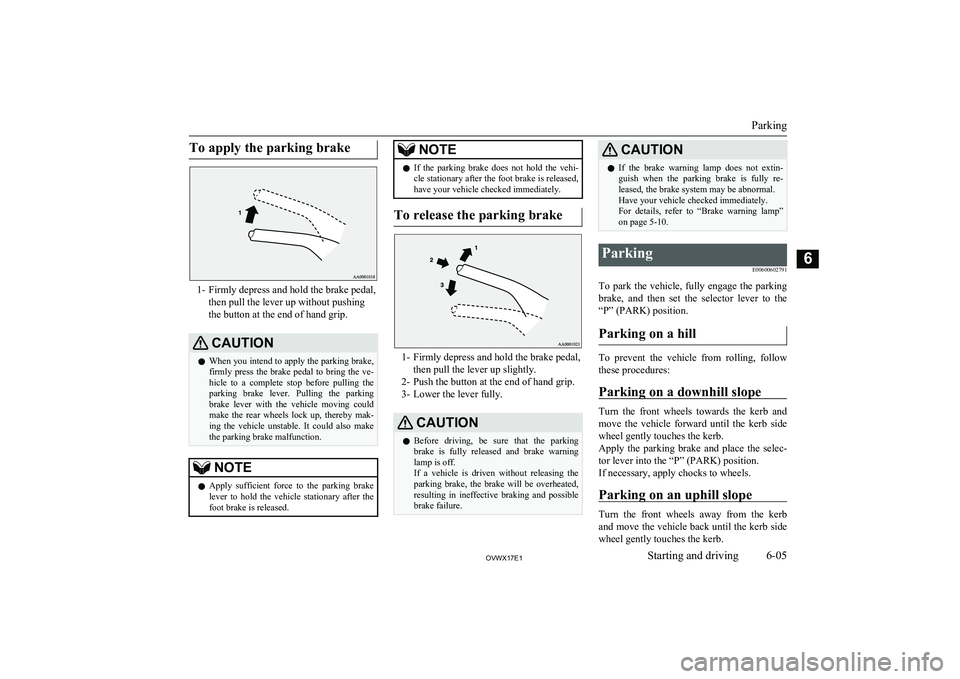
To apply the parking brake
1- Firmly depress and hold the brake pedal,then pull the lever up without pushing
the button at the end of hand grip.
CAUTIONl When you intend to apply the parking brake,
firmly press the brake pedal to bring the ve-hicle to a complete stop before pulling theparking brake lever. Pulling the parking brake lever with the vehicle moving could
make the rear wheels lock up, thereby mak- ing the vehicle unstable. It could also make
the parking brake malfunction.NOTEl Apply sufficient force to the parking brake
lever to hold the vehicle stationary after the foot brake is released.NOTEl If the parking brake does not hold the vehi-
cle stationary after the foot brake is released,
have your vehicle checked immediately.
To release the parking brake
1- Firmly depress and hold the brake pedal,
then pull the lever up slightly.
2- Push the button at the end of hand grip.
3- Lower the lever fully.
CAUTIONl Before driving, be sure that the parking
brake is fully released and brake warning
lamp is off.
If a vehicle is driven without releasing the
parking brake, the brake will be overheated, resulting in ineffective braking and possible
brake failure.CAUTIONl If the brake warning lamp does not extin-
guish when the parking brake is fully re- leased, the brake system may be abnormal.
Have your vehicle checked immediately.
For details, refer to “Brake warning lamp” on page 5-10.Parking
E00600602791
To park the vehicle, fully engage the parkingbrake, and then set the selector lever to the
“P” (PARK) position.
Parking on a hill
To prevent the vehicle from rolling, followthese procedures:
Parking on a downhill slope
Turn the front wheels towards the kerb andmove the vehicle forward until the kerb side wheel gently touches the kerb.
Apply the parking brake and place the selec- tor lever into the “P” (PARK) position.
If necessary, apply chocks to wheels.
Parking on an uphill slope
Turn the front wheels away from the kerb and move the vehicle back until the kerb side
wheel gently touches the kerb.
Parking
6-05OVWX17E1Starting and driving6
Page 144 of 394
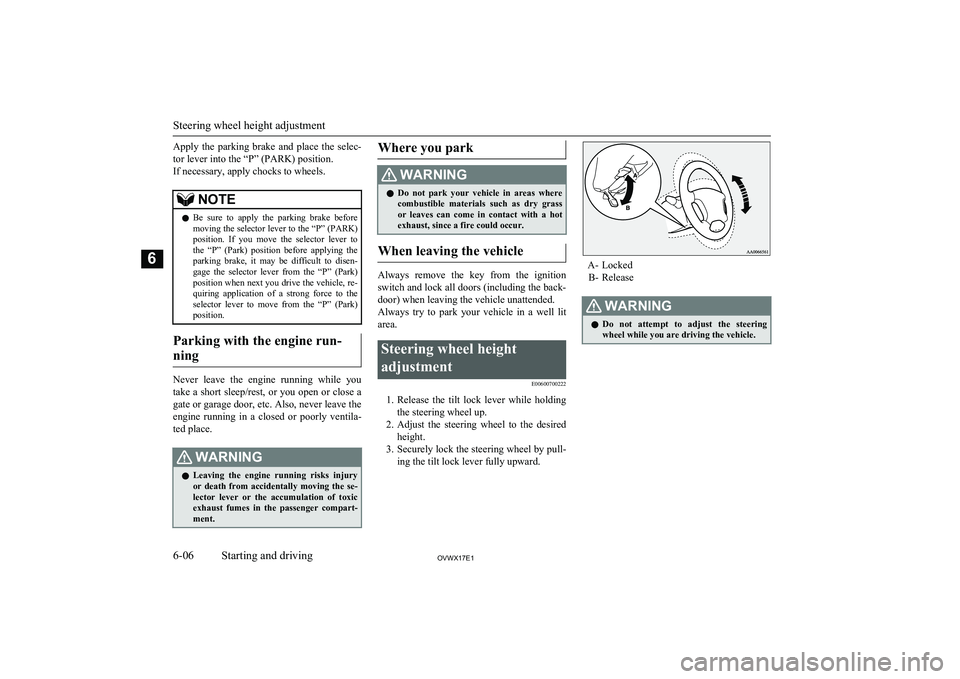
Apply the parking brake and place the selec-tor lever into the “P” (PARK) position.
If necessary, apply chocks to wheels.NOTEl Be sure to apply the parking brake before
moving the selector lever to the “P” (PARK)
position. If you move the selector lever to the “P” (Park) position before applying the
parking brake, it may be difficult to disen-
gage the selector lever from the “P” (Park) position when next you drive the vehicle, re-quiring application of a strong force to the
selector lever to move from the “P” (Park) position.
Parking with the engine run-
ning
Never leave the engine running while you
take a short sleep/rest, or you open or close a gate or garage door, etc. Also, never leave the
engine running in a closed or poorly ventila-
ted place.
WARNINGl Leaving the engine running risks injury
or death from accidentally moving the se- lector lever or the accumulation of toxic
exhaust fumes in the passenger compart-
ment.Where you parkWARNINGl Do not park your vehicle in areas where
combustible materials such as dry grass
or leaves can come in contact with a hot exhaust, since a fire could occur.
When leaving the vehicle
Always remove the key from the ignition
switch and lock all doors (including the back-
door) when leaving the vehicle unattended. Always try to park your vehicle in a well lit area.
Steering wheel height
adjustment E00600700222
1.Release the tilt lock lever while holding
the steering wheel up.
2. Adjust the steering wheel to the desired
height.
3. Securely lock the steering wheel by pull-
ing the tilt lock lever fully upward.
A- Locked
B- Release
WARNINGl Do not attempt to adjust the steering
wheel while you are driving the vehicle.
Steering wheel height adjustment
6-06OVWX17E1Starting and driving6
Page 145 of 394
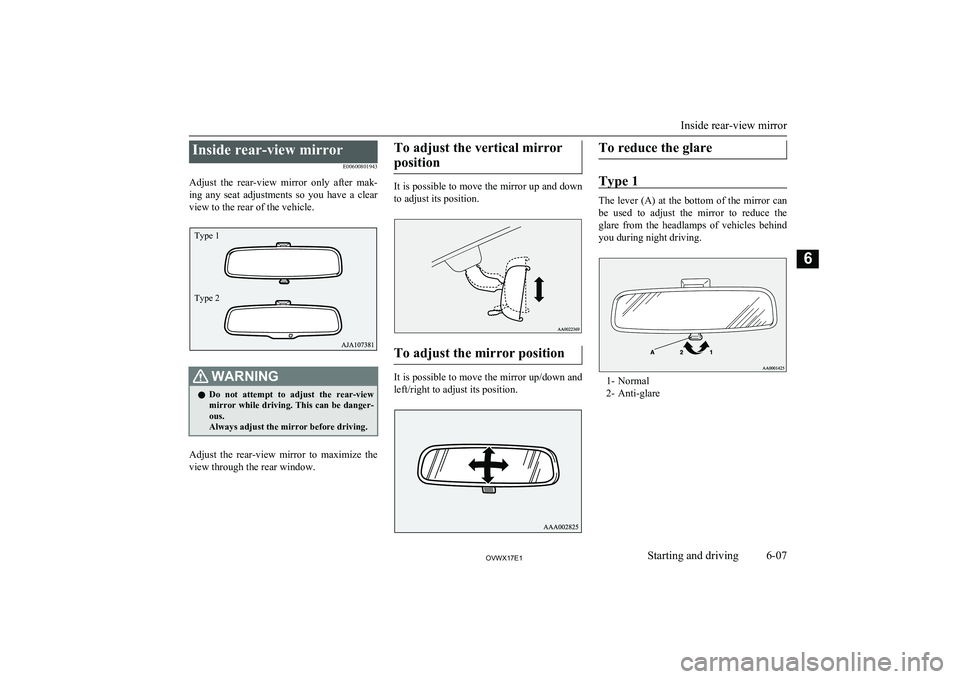
Inside rear-view mirrorE00600801943
Adjust the rear-view mirror only after mak-
ing any seat adjustments so you have a clear
view to the rear of the vehicle.WARNINGl Do not attempt to adjust the rear-view
mirror while driving. This can be danger-
ous.
Always adjust the mirror before driving.
Adjust the rear-view mirror to maximize the
view through the rear window.
To adjust the vertical mirror
position
It is possible to move the mirror up and down
to adjust its position.
To adjust the mirror position
It is possible to move the mirror up/down and left/right to adjust its position.
To reduce the glare
Type 1
The lever (A) at the bottom of the mirror can
be used to adjust the mirror to reduce the
glare from the headlamps of vehicles behind you during night driving.
1- Normal
2- Anti-glare
Inside rear-view mirror
6-07OVWX17E1Starting and driving6Type 2
Type 1
Page 146 of 394
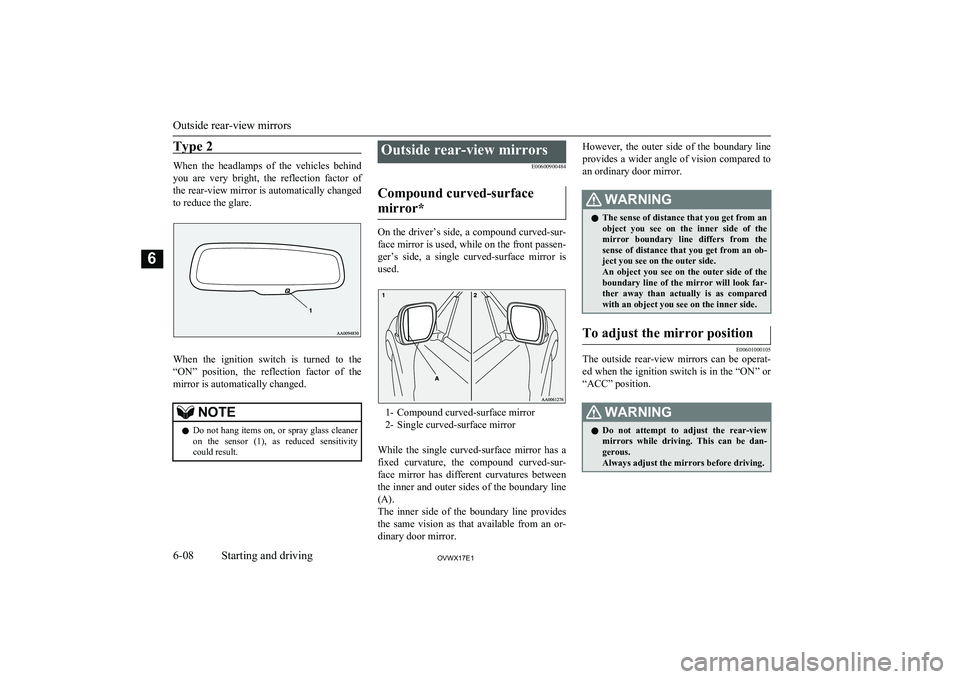
Type 2
When the headlamps of the vehicles behind
you are very bright, the reflection factor of the rear-view mirror is automatically changed
to reduce the glare.
When the ignition switch is turned to the
“ON” position, the reflection factor of the mirror is automatically changed.
NOTEl Do not hang items on, or spray glass cleaner
on the sensor (1), as reduced sensitivitycould result.Outside rear-view mirrors
E00600900484
Compound curved-surface mirror*
On the driver’s side, a compound curved-sur-
face mirror is used, while on the front passen-
ger’s side, a single curved-surface mirror is used.
1- Compound curved-surface mirror
2- Single curved-surface mirror
While the single curved-surface mirror has a fixed curvature, the compound curved-sur- face mirror has different curvatures between
the inner and outer sides of the boundary line
(A).
The inner side of the boundary line provides
the same vision as that available from an or- dinary door mirror.
However, the outer side of the boundary line
provides a wider angle of vision compared to an ordinary door mirror.WARNINGl The sense of distance that you get from an
object you see on the inner side of themirror boundary line differs from the
sense of distance that you get from an ob-
ject you see on the outer side.
An object you see on the outer side of the boundary line of the mirror will look far-
ther away than actually is as compared
with an object you see on the inner side.To adjust the mirror position
E00601000105
The outside rear-view mirrors can be operat-
ed when the ignition switch is in the “ON” or “ACC” position.
WARNINGl Do not attempt to adjust the rear-view
mirrors while driving. This can be dan-
gerous.
Always adjust the mirrors before driving.
Outside rear-view mirrors
6-08OVWX17E1Starting and driving6
Page 147 of 394
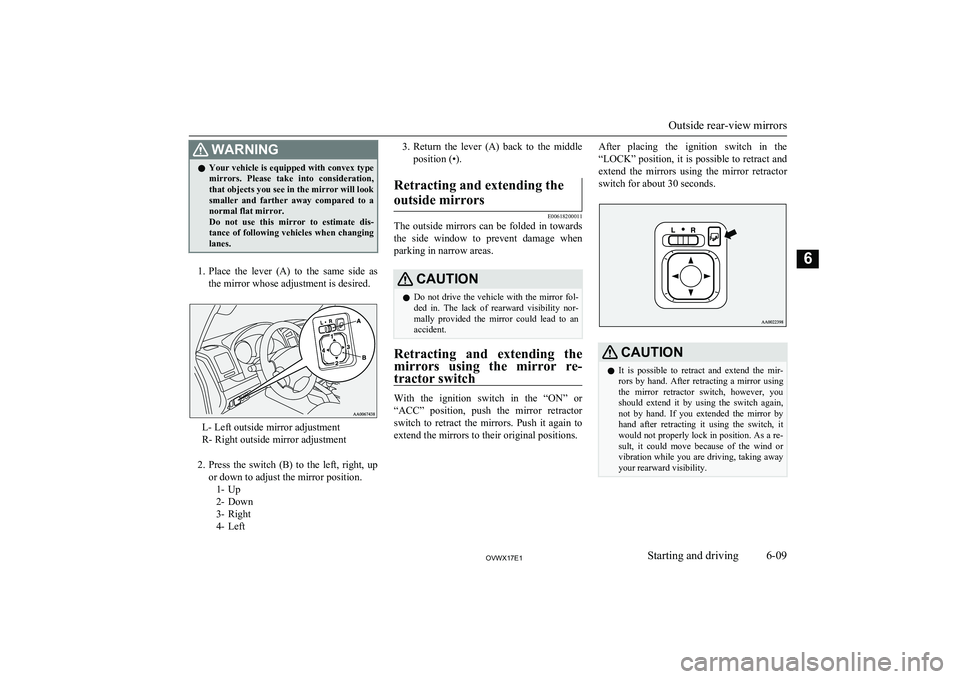
WARNINGlYour vehicle is equipped with convex type
mirrors. Please take into consideration,that objects you see in the mirror will looksmaller and farther away compared to a normal flat mirror.
Do not use this mirror to estimate dis- tance of following vehicles when changing
lanes.
1. Place the lever (A) to the same side as
the mirror whose adjustment is desired.
L- Left outside mirror adjustment
R- Right outside mirror adjustment
2. Press the switch (B) to the left, right, up
or down to adjust the mirror position. 1- Up
2- Down
3- Right
4- Left
3. Return the lever (A) back to the middle
position (•).Retracting and extending the
outside mirrors
E00618200011
The outside mirrors can be folded in towards the side window to prevent damage whenparking in narrow areas.
CAUTIONl Do not drive the vehicle with the mirror fol-
ded in. The lack of rearward visibility nor-mally provided the mirror could lead to an
accident.
Retracting and extending the
mirrors using the mirror re- tractor switch
With the ignition switch in the “ON” or
“ACC” position, push the mirror retractor switch to retract the mirrors. Push it again to
extend the mirrors to their original positions.
After placing the ignition switch in the “LOCK” position, it is possible to retract and
extend the mirrors using the mirror retractor switch for about 30 seconds.CAUTIONl It is possible to retract and extend the mir-
rors by hand. After retracting a mirror using
the mirror retractor switch, however, you should extend it by using the switch again,
not by hand. If you extended the mirror by
hand after retracting it using the switch, it would not properly lock in position. As a re-
sult, it could move because of the wind or
vibration while you are driving, taking away your rearward visibility.
Outside rear-view mirrors
6-09OVWX17E1Starting and driving6
Page 148 of 394

NOTElBe careful not to get your hands trapped
while a mirror is moving.
l If you move a mirror by hand or it moves af-
ter hitting a person or object, you may not be
able to return it to its original position using the mirror retractor switch. If this happens,
push the mirror retractor switch to place the mirror in its retracted position and then push
the switch again to return the mirror to its original position.
l If the battery voltage is low and you start the
engine while extending the mirrors, the mir- rors may stop part-way. If this happens, push
the mirror retractor switch to retract the mir- rors and then push the switch again to extend
them.
l When freezing has occurred and mirrors fail
to operate as intended, please refrain from
repeated pushing of the retractor switch as
this action can result in burn-out of the mir- ror motor circuits.
Automatic extension of mirrors
If the engine is stopped and started with the
mirrors retracted, the mirrors automatically
extend for safety when the vehicle speed rea-
ches 30 km/h (19 mph).
Heated mirror*
E00601200312
To demist or defrost the outside rear-view
mirrors, press the rear window demister
switch.
The indication lamp (C) will illuminate while
the demister is on.
The heater will be turned off automatically in about 20 minutes.Ignition switch
E00601403399LOCK
The engine is stopped and the steering wheel
locked. The key can only be inserted and re- moved in this position.
ACC
The engine is stopped, but the electrical devi-
ces such as the radio and cigarette lighter can be operated.
ON
The engine is running, and all the vehicle’s
electrical devices can be operated.
START
The starter motor operates. After the engine has started, release the key and it will auto- matically return to the “ON” position.
NOTEl Your vehicle is equipped with an electronic
immobilizer. To start the engine, the ID codetransmitted by the transponder inside the key must match the code registered in the immo-bilizer computer.
Refer to “Electronic immobilizer” on page
3-03.
Ignition switch
6-10OVWX17E1Starting and driving6
Page 149 of 394
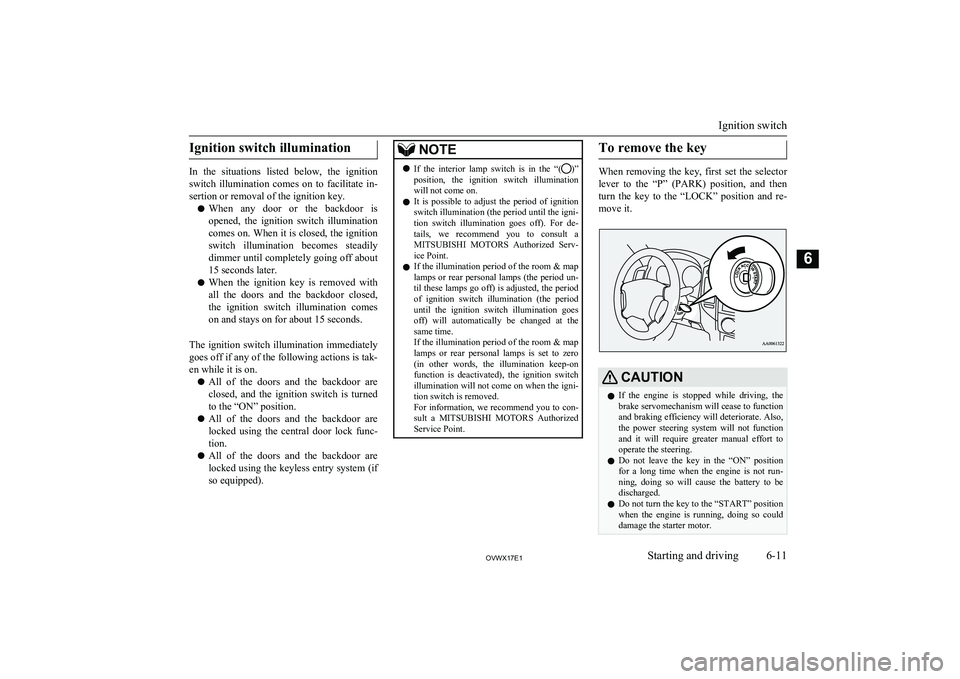
Ignition switch illumination
In the situations listed below, the ignitionswitch illumination comes on to facilitate in-
sertion or removal of the ignition key.
l When any door or the backdoor is
opened, the ignition switch illumination
comes on. When it is closed, the ignition switch illumination becomes steadily
dimmer until completely going off about 15 seconds later.
l When the ignition key is removed with
all the doors and the backdoor closed, the ignition switch illumination comes
on and stays on for about 15 seconds.
The ignition switch illumination immediately goes off if any of the following actions is tak-
en while it is on.
l All of the doors and the backdoor are
closed, and the ignition switch is turned
to the “ON” position.
l All of the doors and the backdoor are
locked using the central door lock func-
tion.
l All of the doors and the backdoor are
locked using the keyless entry system (if so equipped).
NOTEl If the interior lamp switch is in the “()”
position, the ignition switch illumination
will not come on.
l It is possible to adjust the period of ignition
switch illumination (the period until the igni-
tion switch illumination goes off). For de-
tails, we recommend you to consult a
MITSUBISHI MOTORS Authorized Serv-
ice Point.
l If the illumination period of the room & map
lamps or rear personal lamps (the period un-
til these lamps go off) is adjusted, the period
of ignition switch illumination (the period until the ignition switch illumination goes
off) will automatically be changed at the same time.
If the illumination period of the room & map
lamps or rear personal lamps is set to zero
(in other words, the illumination keep-on function is deactivated), the ignition switch
illumination will not come on when the igni-
tion switch is removed.
For information, we recommend you to con-
sult a MITSUBISHI MOTORS Authorized
Service Point.To remove the key
When removing the key, first set the selector
lever to the “P” (PARK) position, and thenturn the key to the “LOCK” position and re-
move it.
CAUTIONl If the engine is stopped while driving, the
brake servomechanism will cease to function and braking efficiency will deteriorate. Also,
the power steering system will not function
and it will require greater manual effort to
operate the steering.
l Do not leave the key in the “ON” position
for a long time when the engine is not run- ning, doing so will cause the battery to bedischarged.
l Do not turn the key to the “START” position
when the engine is running, doing so could damage the starter motor.
Ignition switch
6-11OVWX17E1Starting and driving6
Page 150 of 394
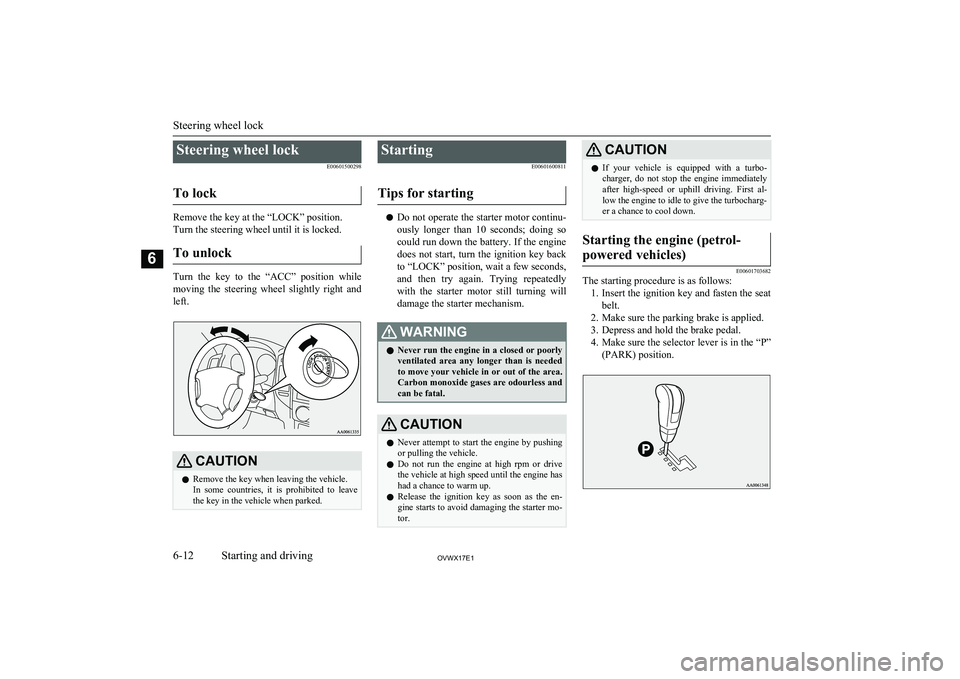
Steering wheel lockE00601500298
To lock
Remove the key at the “LOCK” position.
Turn the steering wheel until it is locked.
To unlock
Turn the key to the “ACC” position while
moving the steering wheel slightly right and left.
CAUTIONl Remove the key when leaving the vehicle.
In some countries, it is prohibited to leave the key in the vehicle when parked.Starting
E00601600811
Tips for starting
l Do not operate the starter motor continu-
ously longer than 10 seconds; doing so
could run down the battery. If the engine
does not start, turn the ignition key back to “LOCK” position, wait a few seconds,and then try again. Trying repeatedly with the starter motor still turning will
damage the starter mechanism.
WARNINGl Never run the engine in a closed or poorly
ventilated area any longer than is needed to move your vehicle in or out of the area.Carbon monoxide gases are odourless and
can be fatal.CAUTIONl Never attempt to start the engine by pushing
or pulling the vehicle.
l Do not run the engine at high rpm or drive
the vehicle at high speed until the engine has had a chance to warm up.
l Release the ignition key as soon as the en-
gine starts to avoid damaging the starter mo-
tor.CAUTIONl If your vehicle is equipped with a turbo-
charger, do not stop the engine immediately
after high-speed or uphill driving. First al-
low the engine to idle to give the turbocharg-
er a chance to cool down.Starting the engine (petrol-
powered vehicles)
E00601703682
The starting procedure is as follows: 1. Insert the ignition key and fasten the seat
belt.
2. Make sure the parking brake is applied.
3. Depress and hold the brake pedal.
4. Make sure the selector lever is in the “P”
(PARK) position.
Steering wheel lock
6-12OVWX17E1Starting and driving6